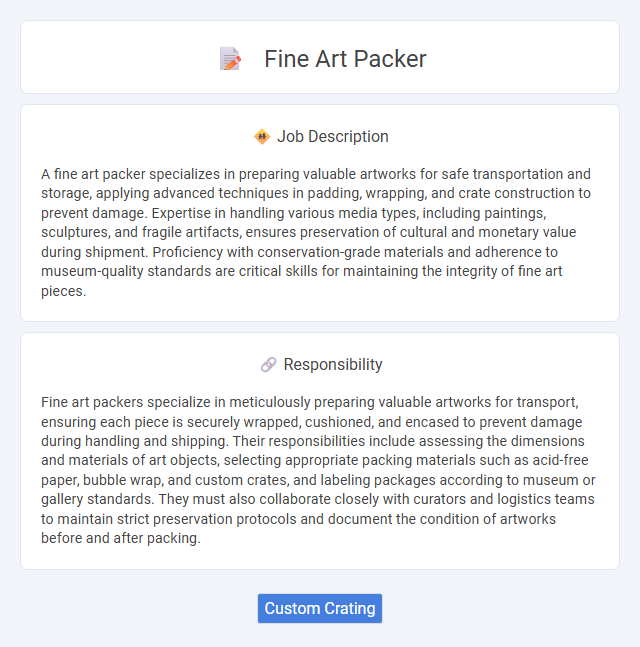
A fine art packer specializes in preparing valuable artworks for safe transportation and storage, applying advanced techniques in padding, wrapping, and crate construction to prevent damage. Expertise in handling various media types, including paintings, sculptures, and fragile artifacts, ensures preservation of cultural and monetary value during shipment. Proficiency with conservation-grade materials and adherence to museum-quality standards are critical skills for maintaining the integrity of fine art pieces.
Individuals with strong attention to detail and physical stamina are likely well-suited for a fine art packer job, as the role demands careful handling of delicate artworks and prolonged periods of standing or lifting. Those who prefer routine, precise tasks and possess a calm, patient demeanor may find this position aligns with their strengths. Candidates who struggle with meticulous work or have physical limitations that hinder safe lifting might face challenges in meeting the job's requirements.
Qualification
A fine art packer requires specialized training in handling delicate and valuable artworks, combining expertise in materials science with precision packing techniques to ensure maximum protection during transportation. Certification in art handling, knowledge of conservation-grade packing materials, and experience with custom crate construction are essential qualifications for this role. Strong attention to detail and familiarity with museum or gallery standards further enhance a fine art packer's ability to safeguard pieces from damage.
Responsibility
Fine art packers specialize in meticulously preparing valuable artworks for transport, ensuring each piece is securely wrapped, cushioned, and encased to prevent damage during handling and shipping. Their responsibilities include assessing the dimensions and materials of art objects, selecting appropriate packing materials such as acid-free paper, bubble wrap, and custom crates, and labeling packages according to museum or gallery standards. They must also collaborate closely with curators and logistics teams to maintain strict preservation protocols and document the condition of artworks before and after packing.
Benefit
Fine art packers likely benefit from specialized training that enhances their attention to detail and handling skills, reducing the risk of damage to valuable artworks. They may experience job satisfaction from protecting and preserving culturally significant pieces, which can foster a sense of pride and responsibility. Opportunities for travel and working with prestigious clients might also increase, providing exposure to diverse environments and professional growth.
Challenge
The fine art packer job likely involves navigating the delicate challenge of handling and protecting priceless artworks during transport and storage. Precision and expertise in materials and techniques probably play a crucial role in minimizing risk and ensuring the integrity of each piece. Managing tight deadlines and complex logistics may also contribute to the demanding nature of this profession.
Career Advancement
A Fine Art Packer specializes in preparing, packing, and protecting valuable artworks for transportation or storage, requiring expertise in handling delicate materials and precise packaging techniques. Career advancement typically leads to roles such as Senior Packer, Logistics Coordinator, or Collections Manager, where supervisory skills and in-depth knowledge of art handling protocols are essential. Proficiency in conservation methods and familiarity with international shipping regulations enhance opportunities for progression within galleries, museums, and art logistics firms.
Key Terms
Custom Crating
Fine art packers specialize in custom crating to ensure the safe transport of valuable artwork by designing and constructing crates tailored to the specific dimensions and fragility of each piece. These custom crates use high-quality materials like plywood, foam padding, and insulation to provide maximum protection against shocks, humidity, and temperature changes during handling and shipping. Expertise in precise measurements, material selection, and secure fastening techniques is essential to prevent damage and maintain the integrity of fine art throughout transit.
 kuljobs.com
kuljobs.com